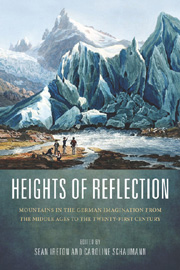 Heights of Reflection
Heights of Reflection Book contents
- Frontmatter
- Contents
- Acknowledgments
- Introduction: The Meaning of Mountains: Geology, History, Culture
- Prelude: Classical Mountain Landscapes and the Language of Ascent
- Part I First Forays: Mountain Exploration and Celebration from the Middle Ages to the Eighteenth Century
- Terra Incognita? Mountains in Medieval and Early Modern German Literature
- From Meadows to Mountaintops: Albrecht von Haller's “Die Alpen”
- Interlude: Geo-Poetics: The Alpine Sublime in Art and Literature, 1779–1860
- Time and Narrative in the Mountain Sublime around 1800
- Faust's Mountains: An Ecocritical Reading of Goethe's Tragedy and Science
- Spectacular Scenery and Slippery Descents: Narrating the Mountains of Tropical Polynesia
- Part II Beckoning Heights: Summits Near and Far in the Nineteenth Century
- Part III Modern Expeditions and Evocations: Climbing from the Twentieth into the Twenty-First Century
- Works Cited
- Notes on the Contributors
- Index
Time and Narrative in the Mountain Sublime around 1800
from Part I - First Forays: Mountain Exploration and Celebration from the Middle Ages to the Eighteenth Century
Published online by Cambridge University Press: 05 February 2013
- Frontmatter
- Contents
- Acknowledgments
- Introduction: The Meaning of Mountains: Geology, History, Culture
- Prelude: Classical Mountain Landscapes and the Language of Ascent
- Part I First Forays: Mountain Exploration and Celebration from the Middle Ages to the Eighteenth Century
- Terra Incognita? Mountains in Medieval and Early Modern German Literature
- From Meadows to Mountaintops: Albrecht von Haller's “Die Alpen”
- Interlude: Geo-Poetics: The Alpine Sublime in Art and Literature, 1779–1860
- Time and Narrative in the Mountain Sublime around 1800
- Faust's Mountains: An Ecocritical Reading of Goethe's Tragedy and Science
- Spectacular Scenery and Slippery Descents: Narrating the Mountains of Tropical Polynesia
- Part II Beckoning Heights: Summits Near and Far in the Nineteenth Century
- Part III Modern Expeditions and Evocations: Climbing from the Twentieth into the Twenty-First Century
- Works Cited
- Notes on the Contributors
- Index
Summary
This essay takes a simple observation as its point of departure, namely that the traversal of mountain landscapes manifests a series of events that lend themselves to being ordered in chronological sequence. Ascending and descending, lingering at striking sights, weathering a storm in a tent or cabin, imagining rocks as they formed over millions of years or witnessing their repositioning in a matter of seconds in a violent avalanche — all these activities involve the experience and often conscious perception of time. Viewed in this light, the notion that mountains are locations in which different events unfold in time might be considered in the more general context of theories of narration. Narrative characteristically represents the unfolding of events or states of being by negotiating the transition from A to B, thus establishing logics of temporal sequence. Todorov, for example, classically defines narrative as the shift “from one equilibrium to another … separated by a period of imbalance.” Transposed into the context of mountain or rock climbing, this minimalist account of narrative serves as a fitting allegory of the climb itself. In the following, I use concepts of the Alpine sublime as a lens for exploring how the mountain landscape operates as a site for experimentation with narrative logics of eventfulness and temporal sequence. I argue that the discourse of the sublime gripped the imagination around 1800 in part because it enabled new ways of narrating human experience; that is, of situating experience in spatial and temporal frames of reference.
- Type
- Chapter
- Information
- Heights of ReflectionMountains in the German Imagination from the Middle Ages to the Twenty-First Century, pp. 98 - 115Publisher: Boydell & BrewerPrint publication year: 2012
